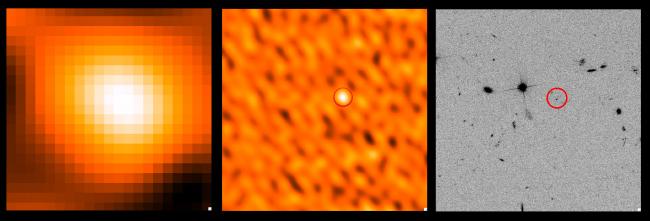
Cambridge, MA
By combining the capabilities of several telescopes, astronomers have spotted extremely bright galaxies hiding in the distant, young universe. The newfound galaxies are intrinsically bright due to their large rate of star formation-1000 times greater than the Milky Way. However, much of that light is hidden by surrounding dust and gas, leaking out only in the infrared.
The galaxies are located about 12 billion light-years away, and existed when the universe was less than 2 billion years old. They are the most luminous and massive galaxies seen at that great distance. Smaller, dimmer galaxies were much more common in the early universe because it takes time for galaxies to form and grow.
"It's a real surprise to find galaxies that massive and luminous existing so early in the universe," said astronomer Giovanni Fazio of the Harvard-Smithsonian Center for Astrophysics (CfA). "We are witnessing the moment when the most massive galaxies in the universe were forming most of their stars in their early youth."
"It's tough to explain how such bright, massive, dusty galaxies formed so early in the lifetime of the universe," added Harvard graduate student Josh Younger.
The hide-and-seek galaxies initially were spotted with the AzTEC imaging camera on the James Clerk Maxwell Telescope. The camera, developed by a team led by Grant Wilson and Min Yun of the University of Massachusetts at Amherst, discovered several hundred previously unseen galaxies that were bright at millimeter and submillimeter wavelengths.
A team of astronomers made follow-up observations of the seven brightest galaxies in an area of the sky studied by the Cosmic Evolution Survey (COSMOS). The Smithsonian's Submillimeter Array pinpointed the exact location of each galaxy, allowing the team to confirm that the source was a single galaxy and not a blend of several fainter galaxies.
Once precise locations were known, additional observations were made with the Hubble Space Telescope, the Spitzer Space Telescope, and the Very Large Array of radio telescopes. Even Hubble's powerful vision did not detect the galaxies, confirming that they are shrouded in dust that blocks visible light. Spitzer could penetrate the dust and detect the stars directly. The Very Large Array detected only the two closest galaxies.
By combining these measurements, the astronomers showed that five of the seven AzTEC galaxies are located at redshifts greater than 3, which corresponds to a distance of 12 billion light-years.
"These results suggest that the brightest submillimeter galaxies may be the most distant," said Fazio.
The galaxies' large infrared brightness indicates that they are forming new stars rapidly, probably due to collisions and mergers.
"The source of the infrared radiation seems to be very compact, which suggests that they are colliding galaxies that may eventually evolve into quasars," said Younger.
In the future, the astronomers plan to image more sources of submillimeter radiation in different cosmic environments, to try to better understand the population.
"We also plan to use the most extended configuration of the SMA to zoom in and try to resolve these objects, and really narrow down the source of their extreme infrared luminosity," added Younger.
These results will be published in the Astrophysical Journal and are available online at http://arxiv.org/abs/0708.1020.
Headquartered in Cambridge, Mass., the Harvard-Smithsonian Center for Astrophysics (CfA) is a joint collaboration between the Smithsonian Astrophysical Observatory and the Harvard College Observatory. CfA scientists, organized into six research divisions, study the origin, evolution and ultimate fate of the universe.
David Aguilar, CfA
617-495-7462
daguilar@cfa.harvard.edu
Christine Pulliam, CfA
617-495-7463
cpulliam@cfa.harvard.edu
Rachel Ehrenberg, U-Mass
413-545-0444
rachele@admin.umass.edu